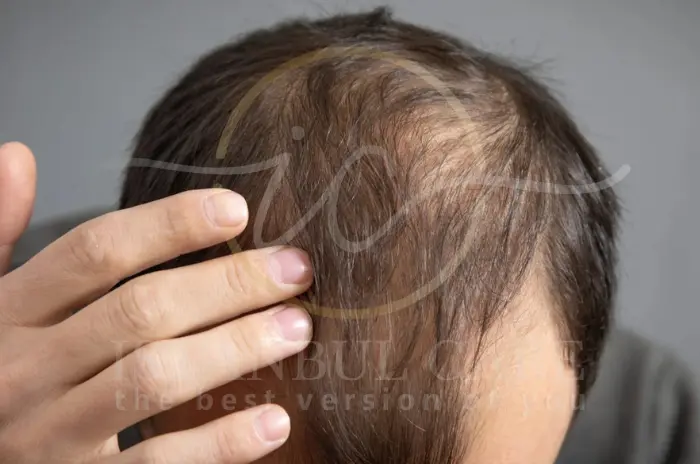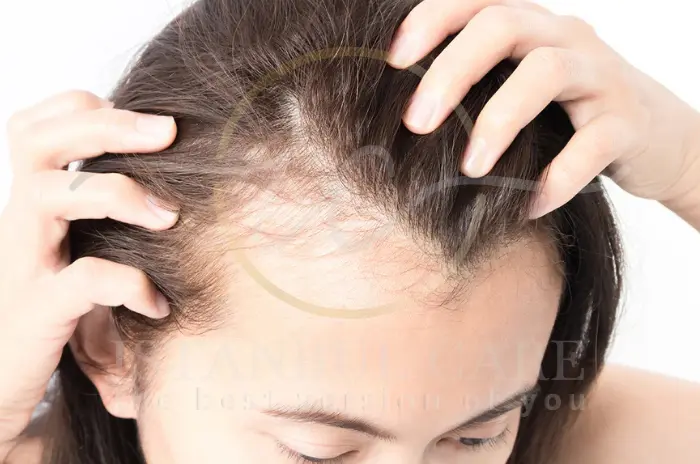Mounjaro (tirzepatide) has gained significant attention as an effective medication for type 2 diabetes and weight management. However, some patients have reported experiencing hair loss while taking this medication, raising concerns about potential side effects. This comprehensive guide explores the relationship between Mounjaro and hair loss, helping you understand what to expect and how to manage this potential side effect.

Does Mounjaro Cause Hair Loss? What You Need to Know
Understanding the Link Between Mounjaro and Hair Loss
While hair loss is not listed as a direct side effect in Mounjaro’s official prescribing information, clinical observations and patient reports suggest a potential connection. The relationship between Mounjaro and hair loss appears to be indirect, primarily related to the rapid weight loss that often occurs with this medication.
Research indicates that significant weight loss, regardless of the method, can trigger a condition called telogen effluvium. This temporary form of hair loss occurs when hair follicles prematurely enter the resting phase of the hair growth cycle, leading to increased shedding 2-4 months after the triggering event.
Key factors that may contribute to hair loss with Mounjaro include:
- Rapid weight loss (more than 2 pounds per week)
- Nutritional deficiencies due to reduced food intake
- Metabolic changes affecting hormone levels
- Stress on the body from significant lifestyle changes
How Common Is Hair Loss with Mounjaro?
The exact prevalence of hair loss among Mounjaro users remains unclear, as it’s not officially tracked in clinical trials. However, anecdotal reports from patients and healthcare providers suggest that hair thinning may affect approximately 5-15% of users, particularly those experiencing rapid weight loss.
| Weight Loss Rate | Risk of Hair Loss | Typical Onset |
|---|---|---|
| 1-2 lbs/week | Low risk | Rare |
| 2-4 lbs/week | Moderate risk | 2-4 months |
| >4 lbs/week | Higher risk | 1-3 months |
Why Might Mounjaro Lead to Hair Thinning?
Mounjaro works by mimicking hormones that regulate blood sugar and slow gastric emptying, leading to reduced appetite and significant weight loss. This mechanism can indirectly affect hair health through several pathways:
The medication’s ability to dramatically reduce caloric intake may lead to insufficient protein, iron, zinc, and vitamin intake—all essential nutrients for healthy hair growth. Additionally, the stress of rapid bodily changes can disrupt the normal hair growth cycle, pushing more follicles into the telogen (resting) phase.
Why Hair Loss Might Happen During Mounjaro Use
The Role of Rapid Weight Loss in Hair Thinning
Rapid weight loss is one of the most significant risk factors for medication-related hair loss. When the body loses weight quickly, it prioritizes essential functions over non-essential ones like hair growth. This biological response is an evolutionary adaptation to preserve energy during periods of perceived scarcity.
The physiological process involves:
- Diversion of nutrients from hair follicles to vital organs
- Hormonal fluctuations affecting the hair growth cycle
- Increased cortisol levels due to physical stress
- Reduced protein synthesis affecting hair structure
Studies show that individuals losing more than 15% of their body weight within six months are at the highest risk for developing telogen effluvium. For Mounjaro users, this translates to those experiencing the most dramatic weight loss results.
Telogen Effluvium and Its Link to Mounjaro
Telogen effluvium is a temporary form of hair loss characterized by diffuse thinning across the scalp. Unlike other types of hair loss, it affects the entire scalp rather than specific areas and is generally reversible once the triggering factor is addressed.
The condition occurs in three phases:
- Triggering phase (0-3 months): The stressor (rapid weight loss) disrupts normal hair cycles
- Shedding phase (2-6 months): Increased hair fall becomes noticeable
- Recovery phase (6-12 months): New hair growth begins as cycles normalize
Other Possible Triggers Behind Hair Loss
Beyond weight loss, several other factors associated with Mounjaro use may contribute to hair thinning:
Nutritional factors play a crucial role, as reduced appetite and food intake can lead to deficiencies in essential nutrients. Iron deficiency, in particular, is common among individuals with dramatically reduced caloric intake and can significantly impact hair health.
Hormonal changes resulting from weight loss can affect hair growth patterns. Insulin sensitivity improvements, while beneficial for overall health, can alter hormone levels that influence hair follicles.
Stress and lifestyle changes associated with starting a new medication and experiencing rapid body changes can trigger hair loss in susceptible individuals.
What to Do If You Notice Hair Loss on Mounjaro
Talk to Your Healthcare Provider
If you notice increased hair shedding while taking Mounjaro, the first step is to consult with your healthcare provider. They can help determine whether the hair loss is related to the medication, rapid weight loss, or other underlying factors.
Your healthcare provider may recommend:
- Blood tests to check for nutritional deficiencies
- Thyroid function tests to rule out hormonal imbalances
- Assessment of your weight loss rate and dietary intake
- Evaluation of other potential causes of hair loss
Questions to ask your healthcare provider:
- Is my rate of weight loss contributing to hair loss?
- Should I adjust my Mounjaro dosage or timing?
- What nutritional supplements might help?
- How long should I expect hair loss to continue?
- Are there warning signs I should watch for?
Nutritional Support and Lifestyle Adjustments
Ensuring adequate nutrition while taking Mounjaro is crucial for maintaining hair health. Despite reduced appetite, focus on consuming nutrient-dense foods that support hair growth.
Essential nutrients for hair health include:
- Protein: Aim for 0.8-1.2 grams per kilogram of body weight daily
- Iron: Include lean meats, spinach, and legumes in your diet
- Zinc: Found in nuts, seeds, and whole grains
- Biotin and B vitamins: Support hair structure and growth
- Vitamin D: Essential for hair follicle health
Consider working with a registered dietitian who understands the challenges of maintaining nutrition while taking GLP-1 medications. They can help create a meal plan that maximizes nutrient intake despite reduced appetite.
Should You Stop Using Mounjaro?
The decision to discontinue Mounjaro should never be made without consulting your healthcare provider. In most cases, hair loss associated with rapid weight loss is temporary and reversible, while the benefits of Mounjaro for diabetes management and weight loss are significant.
Factors to consider:
- Severity and impact of hair loss on quality of life
- Overall health benefits from Mounjaro treatment
- Availability of alternative medications
- Timeline for expected hair regrowth
Your healthcare provider may suggest adjusting the dosage or timing of Mounjaro to slow the rate of weight loss, potentially reducing hair loss while maintaining therapeutic benefits.
How to Manage or Prevent Hair Loss While Taking Mounjaro
Tips to Reduce Hair Shedding During Treatment
While you cannot completely prevent hair loss associated with rapid weight loss, several strategies can help minimize its severity and duration:
Gentle hair care practices:
- Use a wide-tooth comb and avoid excessive brushing
- Choose mild, sulfate-free shampoos
- Limit heat styling and chemical treatments
- Sleep on silk or satin pillowcases to reduce friction
Scalp health optimization:
- Massage your scalp regularly to improve circulation
- Consider using caffeine-based hair products
- Avoid tight hairstyles that pull on hair follicles
- Protect your scalp from sun exposure
- Practice regular meditation or yoga
- Ensure adequate sleep (7-9 hours nightly)
- Engage in gentle exercise as tolerated
- Consider counseling if experiencing anxiety about hair loss

Is Mounjaro Hair Loss Reversible?
The encouraging news is that hair loss associated with rapid weight loss is typically reversible. Most individuals begin to see improvement in hair density 3-6 months after hair shedding peaks, with full recovery often occurring within 12-18 months.
| Timeline | Expected Changes |
|---|---|
| 0-3 months | Hair loss may begin or worsen |
| 3-6 months | Peak shedding period |
| 6-9 months | Shedding slows, new growth begins |
| 9-18 months | Gradual return to baseline density |
Recovery depends on several factors, including the severity of nutritional deficiencies, overall health status, and whether the triggering factors have been addressed.
Comparing Hair Loss with Other GLP-1 Medications
Mounjaro vs Ozempic Side Effects
Both Mounjaro (tirzepatide) and Ozempic (semaglutide) are GLP-1 receptor agonists that can cause significant weight loss, and both have been associated with hair loss in some patients. However, the mechanisms and frequencies may differ slightly.
| Medication | Active Ingredient | Weight Loss Potential | Hair Loss Reports |
|---|---|---|---|
| Mounjaro | Tirzepatide | High (15-20% body weight) | Moderate frequency |
| Ozempic | Semaglutide | Moderate (10-15% body weight) | Similar to Mounjaro |
| Wegovy | Semaglutide (higher dose) | High (15-20% body weight) | Higher frequency |
How GLP-1 Drugs May Indirectly Affect Hair Health
GLP-1 medications don’t directly target hair follicles, but their effects on metabolism, appetite, and weight can indirectly influence hair health through several mechanisms:
Metabolic changes affect how the body processes and distributes nutrients essential for hair growth. Appetite suppression can lead to inadequate intake of calories and nutrients needed for healthy hair production. Rapid weight loss triggers hormonal and physiological stress responses that can disrupt normal hair growth cycles.
Understanding these indirect pathways helps explain why hair loss occurs with these medications and why proper nutrition and monitoring are essential during treatment.
Other Possible Side Effects of Mounjaro
Common Side Effects of Tirzepatide (Mounjaro)
While hair loss is not among the most frequently reported side effects, Mounjaro can cause various other reactions that patients should be aware of:
Gastrointestinal effects (most common):
- Nausea (affects 15-20% of patients)
- Diarrhea (12-16% of patients)
- Vomiting (6-9% of patients)
- Constipation (7-11% of patients)
- Abdominal pain (8-12% of patients)
Other common side effects:
- Fatigue and decreased energy
- Headache
- Dizziness
- Injection site reactions
- Decreased appetite
Most side effects are mild to moderate and tend to improve as the body adjusts to the medication, typically within 4-8 weeks of starting treatment or increasing dosage.
Rare but Serious Side Effects to Watch For
While uncommon, some serious side effects require immediate medical attention:
Severe gastrointestinal complications:
- Severe persistent vomiting or diarrhea
- Signs of dehydration
- Severe abdominal pain
- Gastroparesis (delayed stomach emptying)
Metabolic concerns:
- Severe hypoglycemia (especially when combined with insulin)
- Ketoacidosis in diabetic patients
- Kidney problems due to dehydration
Allergic reactions:
- Rash, itching, or swelling
- Difficulty breathing
- Severe dizziness
If you experience any of these serious side effects, contact your healthcare provider immediately or seek emergency medical care.
The Science Behind Mounjaro and Hair Loss
What is telogen effluvium?
Telogen effluvium is a form of temporary hair loss that occurs when a large number of hair follicles enter the telogen (resting) phase of the hair growth cycle simultaneously. Under normal circumstances, about 10-15% of hair follicles are in the telogen phase at any given time. In telogen effluvium, this percentage can increase to 30% or more.
The hair growth cycle consists of three phases:
- Anagen phase (growth): Lasts 2-7 years, hair actively grows
- Catagen phase (transition): Lasts 2-3 weeks, growth stops
- Telogen phase (rest): Lasts 2-3 months, hair falls out
When stress factors like rapid weight loss disrupt this cycle, many follicles prematurely shift to the telogen phase, resulting in diffuse hair thinning across the scalp.
How rapid weight loss affects hair growth
Rapid weight loss affects hair growth through multiple physiological mechanisms. The body perceives significant caloric restriction as a survival threat, triggering adaptive responses that prioritize essential functions over cosmetic ones like hair growth.
Nutritional impact: Reduced caloric intake often leads to insufficient protein consumption, which directly affects hair structure since hair is primarily composed of keratin, a protein. Micronutrient deficiencies, particularly iron, zinc, and B vitamins, further compromise hair follicle function.
Hormonal changes: Weight loss alters hormone levels, including insulin, leptin, and thyroid hormones, all of which influence hair growth cycles. Decreased leptin levels, in particular, can signal energy conservation mode to hair follicles.
Physical stress response: The body releases stress hormones like cortisol in response to rapid weight changes, which can push hair follicles into the telogen phase prematurely.
Proper nutrition plays a crucial role in preventing and managing medication-related hair loss. When taking Mounjaro, maintaining adequate nutrient intake becomes challenging due to decreased appetite, making strategic nutrition planning essential.
Protein requirements increase relative to total caloric intake when losing weight rapidly. Hair follicles require a constant supply of amino acids to produce keratin effectively. Inadequate protein intake can cause hair to become thin, brittle, and prone to breakage.
Micronutrient absorption may be affected by changes in gastric emptying and food volume. Key nutrients for hair health include iron (for oxygen transport to follicles), zinc (for protein synthesis), biotin (for keratin production), and vitamins A, C, and E (for antioxidant protection).
What to Expect with Mounjaro-Related Hair Loss
Is the hair loss permanent?
The vast majority of hair loss associated with Mounjaro use is temporary and reversible. This type of hair loss, typically classified as telogen effluvium, resolves once the triggering factors are addressed and the body adapts to its new weight and metabolic state.
Factors affecting recovery:
- Age: Younger individuals typically recover faster
- Overall health: Better nutrition and health status promote quicker recovery
- Severity of deficiencies: Addressing nutritional gaps speeds recovery
- Genetic factors: Some individuals are naturally more resilient to stress-related hair loss
Permanent hair loss from Mounjaro is extremely rare and would typically indicate an underlying condition rather than a direct medication effect.
Typical timeline for hair regrowth
Understanding the typical timeline for hair regrowth can help set realistic expectations and reduce anxiety about the process:
Month 1-3: Hair shedding may increase as more follicles enter telogen phase. This can be distressing but is part of the normal process.
Month 4-6: Peak shedding period typically occurs. New hair growth may begin, but these new hairs are initially fine and may not be immediately noticeable.
Month 7-12: Visible improvement in hair density becomes apparent. New hairs gradually thicken and mature.
Month 12-18: Most individuals return to their baseline hair density. Some may notice their hair is slightly different in texture or thickness than before.
When to consult a healthcare professional
While most medication-related hair loss is benign and temporary, certain situations warrant professional evaluation:
Immediate consultation needed:
- Hair loss accompanied by scalp inflammation, pain, or scarring
- Patchy or asymmetric hair loss patterns
- Hair loss continuing to worsen after 6 months
- Signs of underlying nutritional deficiencies (fatigue, weakness, brittle nails)
Routine monitoring recommended:
- Monthly assessment of hair loss severity
- Regular nutritional evaluations
- Monitoring of overall health markers
- Adjustment of treatment plans as needed
Healthcare providers may recommend dermatological consultation for specialized evaluation and treatment options if hair loss is severe or prolonged.
Speak with our expert Hair Transplantation specialists

Speak with our expert Hair Transplantation specialists
We’re ready to answer your questions
Frequently Asked Questions
Mounjaro doesn’t directly cause hair loss, but it can trigger telogen effluvium through rapid weight loss, nutritional changes, and metabolic stress that affects hair growth cycles.
Telogen effluvium is a condition where hair follicles prematurely enter the resting phase of the hair growth cycle, leading to diffuse hair thinning across the scalp. With Mounjaro, this can occur due to rapid weight loss, nutritional changes, and metabolic stress on the body. It typically manifests 2-4 months after starting the medication and experiencing significant weight loss.
While exact statistics are not available from clinical trials, patient reports and healthcare provider observations suggest that hair thinning may affect approximately 5-15% of Mounjaro users. The risk appears to be higher among individuals experiencing rapid weight loss (more than 2-4 pounds per week) and those with pre-existing risk factors for hair loss.
If you notice hair loss while taking Mounjaro, consult your healthcare provider to rule out other causes and assess your nutritional status. Focus on maintaining adequate protein intake, consider appropriate supplements (after medical consultation), practice gentle hair care, and monitor the progression. Most importantly, do not stop Mounjaro without medical supervision.
No, hair loss associated with Mounjaro is typically temporary and reversible. Most individuals begin to see improvement 3-6 months after peak shedding, with full recovery often occurring within 12-18 months. The hair loss is usually classified as telogen effluvium, which is temporary by nature.
To minimize hair loss while taking Mounjaro, ensure adequate protein and nutrient intake despite reduced appetite, take recommended supplements as advised by your healthcare provider, practice gentle hair care techniques, manage stress through relaxation techniques, and maintain regular follow-ups with your healthcare team to monitor your progress.
Hair regrowth typically begins 3-6 months after peak shedding, with noticeable improvement visible by 6-9 months. Full recovery to baseline hair density usually occurs within 12-18 months. The timeline can vary based on individual factors such as age, overall health, nutritional status, and the severity of the initial hair loss.
Hair loss reports are similar across GLP-1 medications including Mounjaro, Ozempic, and Wegovy. The pattern and mechanism appear to be related to the weight loss effects rather than the specific medication. Mounjaro users may experience slightly higher rates due to its potentially greater weight loss effects, but all GLP-1 medications carry similar risks for rapid weight loss-related hair thinning.

